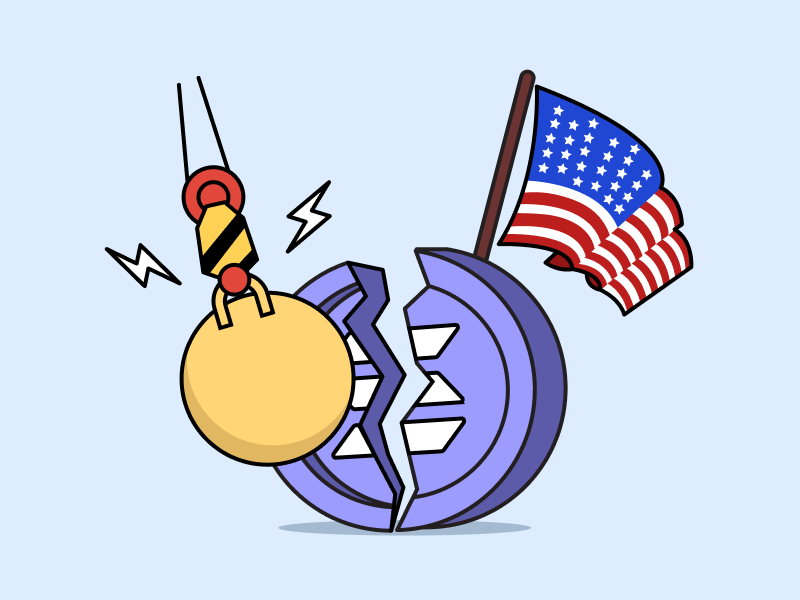Custodial vs. Non-Custodial Wallet – What is the Difference?

In the Web3 world, a crypto wallet plays an essential role in storing and managing your identity in the form of a digital key. This key is required to execute various activities on the blockchain, such as connecting to dApps, sending or receiving crypto assets, buying or selling NFTs, and so on. There are several types of wallets that can be used, including custodial wallets and non-custodial wallets. So, what are custodial and non-custodial wallets, and how do they differ? Let’s read the following article.
Article Summary
- A custodial wallet is a type of wallet that involves a third party in storing and managing users’ private keys, such as a centralized exchange (CEX).
- A non-custodial wallet, also known as a self-custodial wallet, is a type of wallet that gives you full control and ownership over your private keys. Examples include software wallets (Metamask, Exodus, Trust Wallet) and hardware wallets (Ledger, Trezor, KeepKey).
- The difference between custodial and non-custodial wallets is in managing private keys and crypto assets. A third party manages custodial wallets, while the users manage their own non-custodial wallets.
- Custodial wallets are a good choice for new crypto users as they offer convenience and additional features that help in asset management.
- Non-custodial wallets can be an option for users who access dApps more frequently and want full control over their crypto assets, so there is no risk associated with relying on a third party.
What is a Crypto Wallet?
A crypto wallet is a software or service that allows users to store crypto assets and interact with the blockchain network.
Crypto assets are not physically stored in the wallet, but the wallet stores information related to the ownership of the asset and the private key required to make transactions with the asset.
The crypto wallet acts as an interface that allows users to interact with the blockchain network and perform various operations, such as sending and receiving crypto assets, viewing balances, and monitoring transaction history.
A crypto wallet has two main components: the public key and the private key. You can share your public key with others. When someone sends crypto assets to you, they use your public key as the destination address. Meanwhile, the private key is confidential and must be kept safe. The private key is like the pin or password for your bank account. You can sign transactions and transfer crypto assets by having access to the private key.
There are two types of crypto wallets used by crypto users: custodial and non-custodial. Understanding the difference between the two is essential for anyone who wants to get into crypto.
The Difference between Custodial Wallet and Non-Custodial Wallet
The difference between custodial and non-custodial wallets is in managing private keys and crypto assets. Custodial wallets are managed by a third party, such as a centralized exchange (CEX), responsible for the security of the user’s private keys. On the other hand, non-custodial wallets give users full control over their private keys and crypto assets without involving a third party.
As technology evolves and the need for crypto asset security increases, we also know MPC (multi-party computation) wallets. These wallets can be considered semi-custodial wallets because they work by dividing the private keys across multiple trusted parties. As such, no single party has full access to the private keys, preventing the risk of asset loss or theft.
What is a Custodial Wallet?
A custodial wallet is a type of wallet that involves a third party in storing and managing users’ private keys, such as a centralized exchange (CEX). In other words, a custodial wallet is provided by a CEX, such as a Pintu wallet, Binance wallet, Coinbase wallet, and others.
One of the advantages of using a custodial wallet is convenience. A custodial wallet is a good choice for users new to the crypto world because it is easy to use. In addition, custodial wallets also offer additional features such as responsive customer support and account recovery options. You don’t have to worry about losing access to your crypto assets if you forget your password or experience technical issues.
However, when you use a custodial wallet, you lose some control over your funds. That is because your private keys are stored by a third party, which means you have to entrust your crypto assets to that entity. Since your private keys are stored centrally, you are also at risk of suffering losses in the case of a security attack or data leak on the storage platform.
What is Non-Custodial Wallet?
Non-custodial or self-custodial wallets give you full control and ownership over your private keys. In non-custodial wallets, you are solely responsible for keeping your private keys safe and controlling your digital assets. Non-custodial wallets can be software wallets (Metamask, Exodus, Trust Wallet) and hardware wallets (Ledger, Trezor, KeepKey).
It would help if you had a non-custodial wallet to connect with decentralized exchanges (DEX) such as Pancakeswap and Uniswap. Not only that, buying NFTs and playing blockchain-based games (gamefi) can also be accessed with a non-custodial wallet.
The main advantage of using a non-custodial wallet is higher security. Since you have full control over your private keys, no risk is associated with relying on a third party. Hacking attacks on centralized platforms may impact the loss of user funds. By using a non-custodial wallet, you can avoid this risk.
However, using non-custodial wallets may require more technical expertise to set up and use properly. You must understand the basic concepts of cryptographic security and the necessary steps to protect your private keys.
Also, in a non-custodial wallet, you are solely responsible for the security and recovery of your crypto assets. If the private key is lost or an error occurs in storage, restoring access to the funds is impossible. Therefore, you must be careful and disciplined in keeping your private keys safe.
Pros and Cons of Custodial and Non-Custodial Wallet
| Pros | Cons | |
|---|---|---|
| Custodial Wallet | – Easy to use – Accounts can be recovered – Has customer support service | – Losing some control over crypto assets – Centralized security risks |
| Non-Custodial Wallet | – Full control over crypto assets – Higher security – Privacy and decentralized | – Need a higher level of technical expertise – Full responsibility for loss of private keys |
What Crypto Wallet to Use?
When choosing between a custodial wallet and a non-custodial wallet, you need to consider your preferences, level of security, and level of convenience in managing your crypto assets. If you are new to crypto, custodial wallets can be a good option, as they offer comfort and additional features that help with fund management.
MetaMask and Trust Wallet are popular non-custodial wallets for storing crypto assets. MetaMask supports all crypto assets on the Ethereum blockchain and some Ethereum-compatible blockchains such as BSC, Polygon, Fantom, etc. On the other hand, as a multi-coin wallet, Trust Wallet supports up to 70 blockchains.
However, as your experience and understanding of the crypto world increases, you may consider switching to a non-custodial wallet to gain full control over your crypto assets. Non-custodial wallets provide greater security but require you to take full responsibility for securing and recovering your crypto assets. So, you must keep your private keys carefully so they are not lost or even owned by others.
To protect your crypto assets on a non-custodial wallet, you can use a strong password, enable a two-factor authenticator (2FA), not give others your private keys, and do not blindly click on suspicious links.
Read more about how to avoid crypto scams here.
Conclusion
After knowing the differences between custodial and non-custodial wallets, you can determine which wallet suits your needs and preferences. Most crypto users use both types of wallets to store and manage their assets. If you want a convenient trading experience and trust your crypto assets to be managed by CEX, you can choose a custodial wallet. On the other hand, if you prefer to use dApps and manage your own assets, you can choose a non-custodial wallet.
Buy Crypto Aset Crypto in Pintu
Looking to invest in crypto assets? No worries, you can safely and conveniently purchase a wide range of cryptocurrencies such as BTC, ETH, SOL, and others safely and easily at Pintu. Pintu diligently evaluates all its crypto assets, highlighting the significance of being cautious.
Pintu is also compatible with popular wallets such as Metamask to facilitate your transactions. Download Pintu app on Play Store and App Store! Your security is guaranteed because Pintu is regulated and supervised by Bappebti and Kominfo.
Aside from buying and trading crypto assets, you can expand your knowledge about cryptocurrencies through various Pintu Academy articles. Updated weekly, all Pintu Academy articles are made for knowledge and educational purposes, not as financial advice.
References
- Andrew Asmakov, Non-Custodial vs Custodial Wallets: What’s the Difference? Decrypt, accessed 13 Juni 2023.
- Cryptopedia Staff, Custodial vs. Non-Custodial Wallets, Cryptopedia, accessed 13 Juni 2023.
- Jackson Wood, Custodial Wallets vs. Non-Custodial Crypto Wallets, Coindesk, accessed 13 Juni 2023.
- Metamask Team, What is a Crypto Wallet? Metamask Learn, accessed 13 Juni 2023.
- Idoneus Team, What are Seed Phrases, Private Keys, Public Keys, Public Addresses? Idoneus, accessed 13 Juni 2023.
Share
Table of contents


